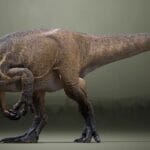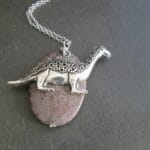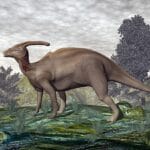Hey there, dino-enthusiast! Let’s take a thrilling trip back in time to the Jurassic period and meet Allosaurus, a top dog of the dinosaur world. This majestic beast was like the king of the jungle, but with teeth the size of bananas! It was a true killing machine, and we’re about to dive into its prehistoric life, from its bone-crushing jaw to the secrets scientists have uncovered from its fossilized remains. So, buckle up and get ready to witness the awesome power of Allosaurus, the Jurassic rock star!
Allosaurus: Reigning Predator of the Jurassic World
Journey back to the Late Jurassic period, approximately 150 million years ago. Imagine a world teeming with colossal creatures, where the air hangs heavy with humidity, and the ground trembles beneath the weight of dinosaurs. Among them stalks the Allosaurus, a true icon of the dinosaur world, known to scientists as the “different lizard.”
This wasn’t just any dino; this was a fierce predator, a meat-eater that dominated the Jurassic landscape. Reaching lengths of up to 28 feet–roughly the size of a school bus!–this beast was built for the hunt. Its powerful body, massive head, and jaw bristling with teeth as sharp as serrated knives made it a formidable force.
Built to Dominate: Anatomy of a Hunter
Let’s break down the Allosaurus’s most impressive features:
Powerful Jaws: While its bite wasn’t as strong as a lion’s, the Allosaurus’s teeth weren’t designed for crushing bones. Instead, their jaws were optimized for slicing and tearing flesh, leaving prey with deep, gaping wounds that likely resulted in rapid blood loss.
Short but Strong Arms: Don’t let the Allosaurus’s short arms fool you. These limbs, though small compared to its body, were incredibly strong and ended in three-fingered hands, each tipped with a wickedly sharp claw. Scientists believe these claws were used to grasp and restrain struggling prey.
A Tail for Balance: With a skull so massive, the Allosaurus needed a way to maintain its balance, especially when running or engaging in combat. Its long, muscular tail acted as a counterweight, ensuring stability even during high-speed pursuits.
Life as a Jurassic Hunter
Home, Home on the Range: The Allosaurus was remarkably adaptable and could thrive in a variety of environments. Fossil evidence suggests it roamed across semi-arid plains, lush forests, and even coastal regions. Its adaptability speaks to its success as a predator.
A Diverse Palate: As a carnivore, the Allosaurus was perpetually on the hunt for its next meal. Its diet likely consisted of large herbivores like the heavily armored Stegosaurus and the more gracile Camptosaurus. While the specifics of its hunting techniques remain a mystery, some scientists believe Allosaurus may have hunted alone or perhaps even cooperated in groups to bring down larger prey.
The Cleveland-Lloyd Dinosaur Quarry Conundrum: This site in Utah has yielded hundreds of Allosaurus bones–more than any other dinosaur species found there! This unusual concentration has sparked a number of intriguing theories. Did a watering hole during a drought transform into a deadly predator trap? Did Allosaurus congregate in groups for reasons beyond hunting? Scientists are still uncovering clues to solve this prehistoric puzzle.
A Unique Dinosaur, Still Full of Surprises
A Bite Designed to Kill: Though not possessing the strongest bite in the dinosaur kingdom, the Allosaurus’s jaw was uniquely designed to inflict massive blood loss on its prey, speaking to a specialized killing technique.
Head Crests – What’s Their Story?: The Allosaurus sported bony crests above its eyes. The purpose of these crests remain a mystery. Did they serve a signaling function, aiding in communication or attracting mates? Could they have been used to differentiate between different species of Allosaurus? More research is needed to unlock the secrets of these enigmatic crests.
Mapping the Allosaurus’s Domain: New discoveries are constantly expanding our understanding of the Allosaurus’s range. Who knows what other secrets about this incredible predator are waiting to be unearthed?
Anatomy: A Closer Look at the “Different Lizard”
Let’s delve deeper into the anatomy of the Allosaurus and imagine what it would be like to come face-to-face with this Jurassic giant.
Picture a massive, lizard-like creature, stretching out almost the length of a school bus–around 28 feet! That’s the Allosaurus. Its skeleton was built like a tank, with a skull so strong it seems as though it could smash through a wall. And let’s not forget those teeth, sharp as knives and perfectly designed for ripping through flesh.
Built for speed, this dinosaur’s powerful legs rivaled those of a cheetah. Its muscular thighs propelled it forward with incredible speed as it chased down its prey, making it a force to be reckoned with.
Now, here’s the feature that truly set Allosaurus apart: its spine. Unlike most dinosaurs, which had differently shaped vertebrae, the Allosaurus had concave vertebrae–curved inward. This unique characteristic is what earned it the nickname “different lizard.” But these vertebrae weren’t just for show; they provided the Allosaurus with incredible flexibility, allowing it to twist and turn with surprising agility for a creature of its size.
But how did the Allosaurus manage its massive head and body without being clumsy? Its secret weapon was its tail. This thick, muscular appendage acted as a counterweight, keeping everything in balance. Think of it as a built-in gyroscope, ensuring stability even during high-speed chases or when delivering powerful attacks.
Weighing in at a massive 1.5 to 2 tons–heavier than your average car!–the Allosaurus’s size and powerful build made it the apex predator of its time.
Allosaurus: A Legacy Etched in Bone
Imagine a time when the Earth trembled beneath the weight of colossal plant-eaters. Among these giants roamed a creature that struck fear even into these behemoths – the Allosaurus. This wasn’t just another dinosaur; it was the king of the Late Jurassic, a predator whose impact continues to resonate millions of years later.
So, what made the Allosaurus so extraordinary? Picture a creature that could grow up to 28 feet long–longer than a school bus!–equipped with a massive skull, jaws strong enough to crush bone, and teeth like rows of steak knives, perfect for ripping and tearing flesh.
Scientists believe the Allosaurus was an intelligent hunter. While fast on its feet, it probably relied more on strategy than pure speed. Some experts even suggest that these predators formed packs to bring down larger dinosaurs, coordinating their attacks like a prehistoric SWAT team. Can you imagine a group of these fearsome predators working together to take down prey much larger than themselves?
The Allosaurus was a creature of its time, inhabiting lush forests, vast plains, and even coastal areas. Its appetite matched its diverse habitat, feasting primarily on large, lumbering herbivores such as Stegosaurus and Camptosaurus.
But the Allosaurus was more than just teeth and muscle. It possessed a number of unique features. For instance, its jaw wasn’t just about brute strength; it appears to have been designed in a way that would have caused massive blood loss in its prey. Then there are those bony crests above its eyes, the purpose of which continues to baffle scientists. Were they for display? Protection? Something else entirely? These mysteries are still being unraveled.
The most exciting thing about the Allosaurus is that we’re still learning about it. Every new fossil brings us closer to understanding how it lived, hunted, and interacted with its environment. What else will we learn about this incredible predator? Only time – and further exploration – will tell!
The Apex Predator’s Menu: What Did Allosaurus Hunt?
The Allosaurus was at the top of the food chain, the ultimate diner in the Late Jurassic period. But what, exactly, was on this fierce creature’s menu?
A Hunter’s Toolkit: How Allosaurus Took Down Its Prey
The Allosaurus wasn’t just big and strong; it seems to have been a clever hunter. This dinosaur had it all: sharp senses, a powerful body built for the chase, teeth like knives, and a muscular tail for balance and agility. Some scientists believe that these predators may have even hunted in packs, coordinating their attacks to bring down truly large dinosaurs.
Dinner Time in the Jurassic: The Allosaurus’ Preferred Menu
So, what was the Allosaurus craving for dinner? Stegosaurus, with its spiky plates, was likely a regular item on the menu. Paleontologists have found bite marks on Stegosaurus bones that match the Allosaurus’s teeth. And when a smaller, less-armored meal was in order, Camptosaurus, a smaller herbivore, likely became an easy target.
Did Allosaurus Dare to Attack the Giants?
Now, things get really interesting. We used to think that gigantic sauropods—dinosaurs like Brachiosaurus and Diplodocus, with their long necks and massive bodies—were simply too enormous for even the Allosaurus to tackle. But recent discoveries have challenged this assumption. Scientists have found Allosaurus teeth near sauropod skeletons and, even more compellingly, bite marks on sauropod bones that could have only been made by an Allosaurus. This suggests that even the largest dinosaurs of the Jurassic weren’t entirely safe from the Allosaurus. However, it’s still a topic of debate, and more evidence is needed.
A Jurassic Mystery Still Unfolding
As we continue to learn more about this incredible predator, it’s clear that the Allosaurus played a crucial part in shaping the Jurassic world. The variety of prey it pursued made it one of the most impressive carnivores of its time. Who knows what other fascinating discoveries await us in the world of paleontology!
The Apex Predator of the Jurassic: Allosaurus and How It Reigned
The Allosaurus was a dominant force in the Late Jurassic period. But how exactly did this massive carnivore maintain its reign over its ecosystem? Let’s take a look.
Hunting Strategies: A Closer Look
Imagine being a plant-eating dinosaur, peacefully munching on ferns, completely oblivious to the danger lurking nearby. That’s where Allosaurus excelled. This cunning predator likely employed ambush tactics, using camouflage to blend into the environment before exploding from cover and delivering a fatal blow.
But Allosaurus wasn’t just a solo artist. Some paleontologists suggest that these predators may have cooperated in packs, which would have allowed them to take down even the largest herbivores, such as the mighty sauropods.
On the Menu: A Dinosaur Buffet
Allosaurus wasn’t a picky eater. This opportunistic predator likely feasted on whatever prey was available. While sauropods may have been a prize catch, Allosaurus probably didn’t hesitate to snag a Stegosaurus or a smaller Camptosaurus.
A World of Competition: Not Without Challenges
Being at the top doesn’t mean life was easy. Allosaurus may have been the apex predator, but it still had to contend with other large carnivores vying for the same resources. Ceratosaurus, with its distinctive horns, and the massive Torvosaurus would have been formidable rivals. Competition for food and territory was likely fierce.
Unraveling the Mysteries: What We’re Still Learning
While fossil evidence provides a fascinating glimpse into the world of the Allosaurus, many questions remain. How, exactly, did Allosaurus hunt in packs? What was the nature of their interactions with other predators? Ongoing research continues to refine our understanding of this captivating dinosaur. The study of Allosaurus, like all paleontology, is an evolving field.
Allosaurus vs. T-Rex: A Jurassic Showdown
They are two of the most iconic predators to ever walk the Earth, but how would the agile Allosaurus have fared against the mighty Tyrannosaurus Rex in a hypothetical Jurassic showdown?
Allosaurus: The Agile Assassin
Picture a warm Jurassic landscape. A herd of hefty plant-eaters grazes peacefully, unaware of the danger lurking nearby. Suddenly, a pack of sleek, powerful Allosaurus bursts from the undergrowth! Allosaurus were agile hunters, darting and weaving, using their powerful legs to chase down prey. They weren’t as large as T-Rex, but their speed, agility, wicked claws, and serrated teeth made them a force to be reckoned with.
T-Rex: The Cretaceous Crusher
Fast forward millions of years, and the mighty Tyrannosaurus Rex reigns supreme. This wasn’t a creature built for speed; it was a powerhouse! Imagine the ground trembling with every step, its massive skull and bone-crushing jaws striking fear into the hearts of any creature that crossed its path.
Sizing Up the Titans
So, how did these prehistoric behemoths measure up?
Size and Weight: T-Rex was undoubtedly the heavyweight champ, potentially reaching lengths of 40 feet and weighing a staggering 8 tons! Allosaurus, while still impressive at around 30 feet and 2-3 tons, was significantly smaller.
Speed and Agility: Allosaurus takes the lead in this category. Its lighter build and powerful legs likely made it much faster and more agile. While not as nimble, T-Rex was no slouch and could still outrun many dinosaurs.
Hunting Styles: Allosaurus might have been a team player, with fossil evidence suggesting pack hunting, while T-Rex was probably a solo act, relying on its sheer power and keen senses.
The Verdict? A Prehistoric Puzzle
There’s no easy answer to who would win in a fight.
Some experts believe Allosaurus’s speed and agility would give it an edge, allowing it to harass the larger T-Rex. Others argue that one well-placed bite from T-Rex’s massive jaws would be game over for Allosaurus. Ultimately, the outcome would depend on many factors: terrain, the age and health of the individuals, and a healthy dose of luck!
Unraveling the Cleveland-Lloyd Dinosaur Quarry
The Cleveland-Lloyd Dinosaur Quarry isn’t your average fossil site. This place is littered with more predator bones than prey, making it a puzzling prehistoric enigma that scientists have been trying to understand for years.
Death Trap or Dinosaur Oasis?
Imagine a dinosaur graveyard frozen in time. That’s the Cleveland-Lloyd Dinosaur Quarry, home to over 12,000 bones from at least 74 different dinosaurs. But here’s the thing–most of those bones belonged to meat-eaters! This unusual concentration raises a lot of questions. Why would so many predators end up in the same location?
One theory is that the quarry was a predator trap. Perhaps it was a muddy pit or a sinkhole that dinosaurs wandered into, only to become stuck, attracting hungry predators like Allosaurus, who also became trapped. While this might sound like a scene out of Jurassic Park, the quarry doesn’t appear to have the geological features to support this theory.
Another possibility is that a severe drought brought all these dinosaurs together around a shrinking waterhole. As the water disappeared, the dinosaurs would have died in large numbers. This theory seems more likely, as evidence suggests the area was quite dry during the Late Jurassic.
The Curious Case of the Allosaurus Abundance
The Cleveland-Lloyd Dinosaur Quarry is overflowing with Allosaurus bones–a staggering 75% of all the fossils found there! This kind of imbalance, with so many predators and so few prey animals, has never been seen at any other dinosaur fossil site.
So, why were there so many Allosaurus in this location? Did they live and hunt in large packs? Or were they drawn to the area by the smell of rotting carcasses, scavenging on dinosaurs that had already succumbed to drought or other factors?
The Investigation Continues
Scientists are continually searching for clues to solve the mystery of this unusual fossil site. New technology is playing a big role. For example, scientists can now use isotopic analysis to figure out what these dinosaurs ate and learn more about their environment.
The Cleveland-Lloyd Dinosaur Quarry is a powerful reminder that the past still holds many stories to tell.
Allosaurus in Popular Culture: A Jurassic Icon
The Allosaurus hasn’t just been relegated to dusty museums. This fearsome predator has become a pop culture icon, appearing in documentaries, Hollywood blockbusters, and more.
One of the most impactful portrayals of the Allosaurus occurred in 1999 with the BBC’s groundbreaking documentary series, “Walking with Dinosaurs,” specifically the episode “The Ballad of Big Al.” This Emmy-winning special chronicled the life of a single Allosaurus whose fossilized remains revealed evidence of injuries and diseases. The documentary’s empathetic portrayal of Big Al as an individual resonated with audiences, transforming the Allosaurus from a monstrous lizard to a creature of depth and complexity.
In 2005, the Allosaurus took on the big screen in Peter Jackson’s “King Kong” remake. While not the film’s primary antagonist, it makes a memorable appearance, battling Kong and other creatures and reinforcing its image as a powerful and aggressive predator.
The Allosaurus’ appearances in popular culture, while rooted in scientific understanding, also draw upon our imaginations and shape the way we view these extinct animals. What other prehistoric creatures will one day step out of the shadows and into the spotlight?
Key Points:
- Size and Appearance: Allosaurus was a large predator that reached lengths of up to 28 feet, with a powerful body, massive head, and sharp teeth.
- Hunting Adaptations:
- Powerful jaws with slicing teeth for inflicting severe wounds and causing blood loss
- Short but strong arms with sharp claws for gripping prey
- Muscular tail to maintain balance while running and fighting
- Habitat and Diet:
- Adaptable to various environments, including plains, forests, and coastal areas
- Carnivore that likely preyed on large herbivores such as Stegosaurus and Camptosaurus, and possibly even sauropods
- Mystery of the Cleveland-Lloyd Dinosaur Quarry:
- Excavated hundreds of Allosaurus bones, prompting theories about predator traps or group gatherings
- Unique Features:
- Specialized jaw for causing blood loss in prey
- Bony crests above the eyes, whose purpose remains unclear
- Ongoing Research:
- New discoveries continue to expand our knowledge of Allosaurus’s habitat and behavior
Did you know the archaeopteryx, the oldest known bird, had feathers that resembled those of modern birds? Or that the argentinosaurus huinculensis, an enormous dinosaur, was larger than any other dinosaur we know about today?
- Unlock Water’s Symbolism: A Cross-Cultural Exploration - April 20, 2025
- Identify Black and White Snakes: Venomous or Harmless? - April 20, 2025
- Unlocking Potential: Origins High School’s NYC Story - April 20, 2025














